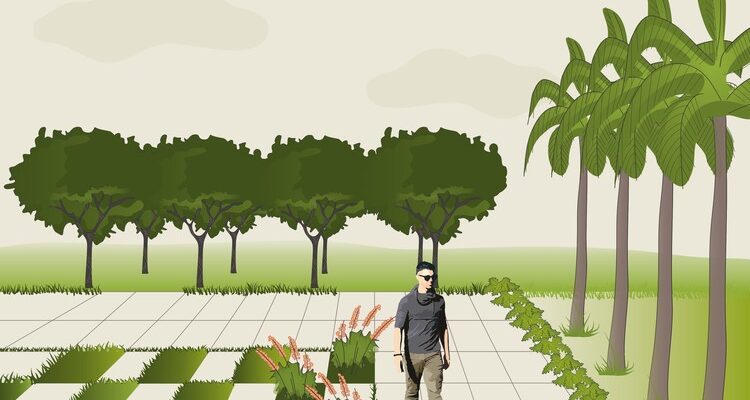Having an outdoor space to spend your weekends in is one of the best things about having a landscaped property. Besides enhancing your property’s investment viability, landscaped yards also provide countless benefits, such as the following:
- Plants in landscaped yards bring cooler air.
- The foliage helps reduce air, water, soil, and noise pollution.
- Well-designed landscapes protect the water supply and natural ecology in the area.
- Landscaped yards serve as excellent spaces to entertain guests, bond with your loved ones, or relax on your days off.
To enjoy these benefits and more, you have to make sure you understand how landscapes are made, starting with the design.
Like artworks on a canvas or printed on a magazine, landscape design uses the usual design composition tools. These elements work together in transforming outdoor space into a unique and experiential spot for you and your family.
In this post, we’ll explain the seven vital elements of landscapes and why they are essential in planning its design.
1. Lines
Lines can be vertical, horizontal, diagonal, and curved. They are used in landscapes to control movement, accentuate objects, and draw attention to certain sections that serve as focal points of the space, like water features and fire pits.
This element may not be immediately apparent, but it can be found all around the landscape design, like walkways or garden paths. Changes in lines also offer different vibes (e.g., a meandering walkway creates a sense of surprise).
Landscapers use two types of lines: real (actual) and perceived (implied) lines. Real lines are the obvious ones created with stone paths, walkways, and perimeter fences. On the other hand, perceived lines are those created by organizing individual objects – such as plants – to form an implied line.
2. Color
Color is the most conspicuous and most-used element in landscape design. In many cases, it is also overused.
It comes in two “temperatures”: warm and cool. Among the hues categorized under the warm color temperature are yellows, reds, and oranges. Cool colors are shades of blue, purple, and green.
Different combinations of warm and cool colors result in varying visual impacts. Each one also incites unique moods, depending on how it is used.
In a landscape, color is a vital consideration in the selection of plants (particularly flower and foliage) and hardscape. It should also be incorporated in the planning of blooms around the yard and woven throughout the design based on different seasons.
3. Form
Form in landscaping describes the unique shapes of objects in a landscape. Many forms exist in a single landscape, including the rectilinear shapes of walkways, driveways, and the house.
Plants also have a variety of shapes. Examples of plant shapes include round, oval, conical and vase.
When placed in groups, plants take on a new form as a whole, distinct from their individual shapes.
Forms are important in landscape design because they create a unique ambiance and set the mood of the entire space. Rectilinear forms feel more formal, while irregular shapes are more casual. Triangular forms exude a sense of strength, while round forms provide a softer feel.
4. Mass
Mass measures the visual size – or the space occupied – of an individual or group of objects. Each plant has its own specific mass, but it becomes part of a bigger group with a different mass when planted on a flower bed.
Besides plants, other objects in a landscape also have mass, including the house, patio, or arbor. Considering the visual size of these components of the design can help you achieve a more balanced bigger picture.
In this case, balance means achieving a sense of equality across the design. It can also be symmetrical and asymmetrical.
Symmetrical balance simply means that the two sides of the landscape have equal or identical elements. On the other hand, asymmetrical balance is achieved by using different combinations of objects on either side, but with similar visual weight.
For example, similar plant beds placed on either side of a focal point (the adjacent lawn, a hardscape, or the house) creates symmetrical balance. Meanwhile, a mass of different plants within a single bed that occupies a proportionate space to the overall planting has a kind of asymmetrical balance.
5. Texture
Texture in landscape design describes the surface characteristics of objects, which can be coarse, medium, or smooth. From plants to pavements, all landscape components have their own unique textures.
Using contrasting textures makes a landscape more visually appealing. However, different textures on their own achieve varying visual effects: smooth or fine textures make the space look bigger while coarse surfaces draw the eye and make it look smaller.
For plants, the textural attribute covers the flowers’ shapes and the form and surface of leaves, barks, and stems. When used wisely, these can enrich the visual quality of landscape design.
6. Repetition and Transitions
Two more elements that help create a beautiful landscaped scenery are repetition and transition.
As the name implies, repetition means adding the same elements several times that make a garden look more organized and elegant. In a way, repetition can unify a landscape design as it ensures that, even with several forms and elements included, there will still be a sense of wholeness that completes the bigger picture.
Putting too many unrelated objects together makes the design look cluttered and unplanned. In contrast, overuse of a certain element can leave the landscape looking boring, monotonous, and uninteresting.
On the other hand, transition refers to gradual changes in the landscape. This can be illustrated with gradual variations in plant color, intensity or size. This design element can also be applied to form and texture.
7. Theme
Themes are useful for a lot of things, and landscape design is no exception.
Besides making the landscaping design company’s work easier, having a theme unifies the landscape design and guides your material and plant choices. It also allows you to visualize all the components to be used in the landscape – from the plants and hardscape to decorations and other structures – and set more realistic expectations for the space.
Unless you’re building them simultaneously, you may need to look at your house and match the landscape theme with its architecture. Consider the lines and style already present in the property to create a continuous flow of the design.
The Takeaway
The smartest thing to do when planning a landscape project for your property is to hire professionals when planning for your landscape design. However, it is always better to enrich your knowledge on the matter, to offer appropriate input on the design.
AUTHOR BIO
Rachel Hennessey manages the Pools and Landscaping Division of Hennessey LLC. She also works on Tender and Pre-Qualification and brings in new business to the company’s Construction, Interiors, and Civils Division.




